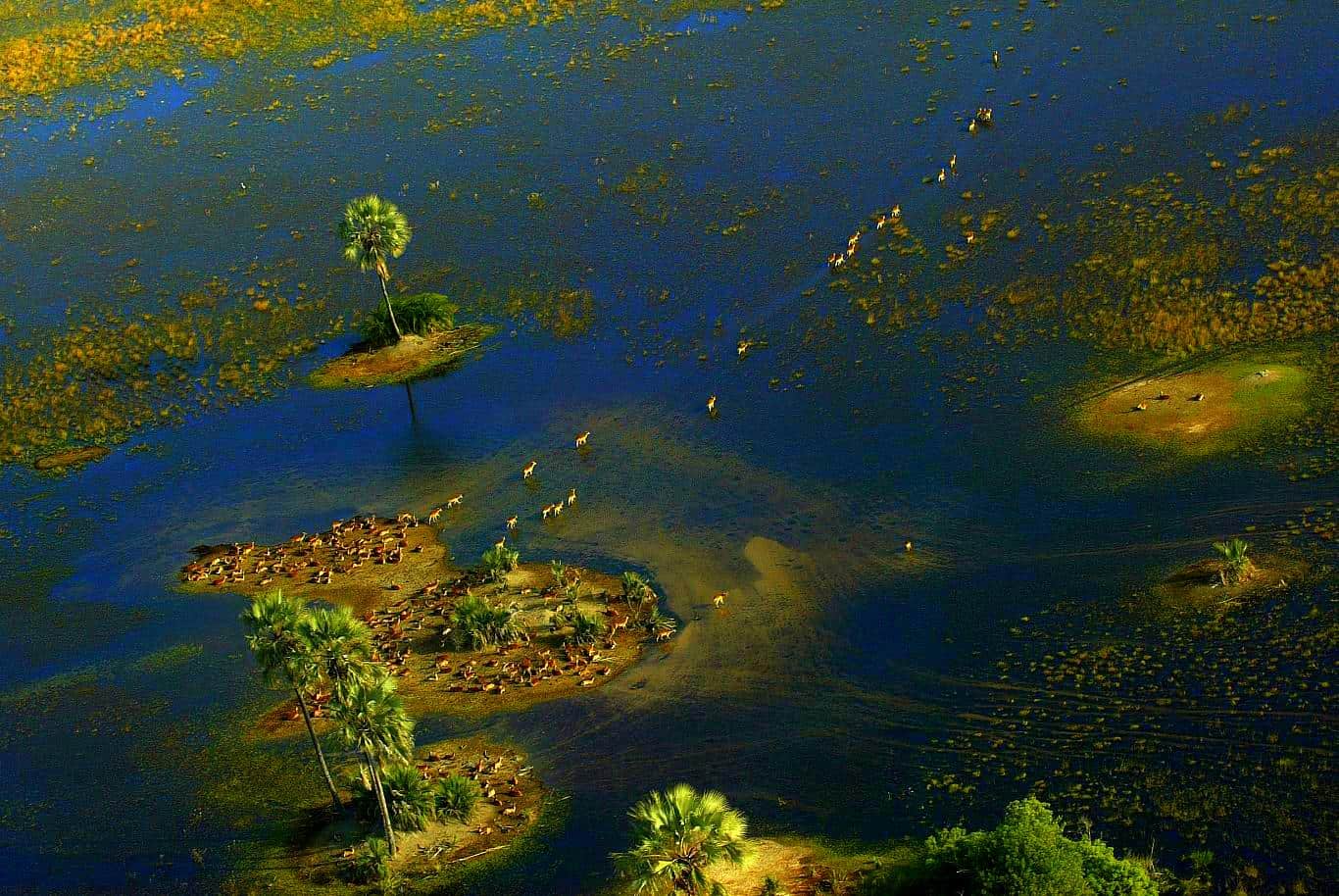 Botswana Tourism Organization
Botswana Tourism Organization
By Merle Rosenstein
Deep in the heart of Africa, stunning Botswana shines as a top safari destination. The winding waterways, lush grasslands, striking salt pans and vast desert plains attract roaming herds of wild game and exotic birds. Opportunities for wildlife viewing abound in Botswana’s interior. Visitors can jump in a jeep and track a herd of wild elephants, roll down the river in a mokoro (dugout canoe) or take flight in a hot air balloon. And with an area of 581,730 square kilometres (about the size of France or Kenya), Botswana has plenty of territory to explore.
Here are some of the top wildlife viewing areas in Botswana:
The Moremi & Okavango Region
The Okavango Delta is the largest inland delta system in the world – a 15,000 square kilometre series of waterways, lagoons, swamps and islands. The water from the Delta originates 1,600 kilometres away in the highlands of Angola. The islands of the Delta attract great numbers of animals that come from miles around, including elephants, zebras, kudus, gazelles, buffaloes and lions. Moremi Game Reserve, a 3,000 square-kilometre protected area covering about 20 per cent of the Okavango Delta, has a wide range of habitats from wetland and reed beds to forest and savannah woodland. Exotic birds, zebras, buffalo, wildebeest and giraffes, hippos and lions all call the Moremi Game Reserve home. One of the most popular safari destinations for big game, the Moremi Game Reserve hosts day and night game drives, walking safaris and mokoro rides. Private game reserves have luxury camps and exclusive safaris. The number of lodges and camping sites is limited to protect the environment.
 Botswana Tourism Organization
Botswana Tourism Organization
The Chobe Region
Best known for the size of its elephant population, Chobe National Park boasts one of the largest game concentrations on the African continent. During the dry season, big game gather at the Chobe riverfront. Further south, the less crowded Savute, offers excellent views of elephants and lions, the endangered wild dog, leopard, cheetah and the hyena. During the summer, the Savute offers prime birding opportunities.
The Linyanti Wildlife Reserve with its lagoons, rivers, forests, grasslands and dry wooded areas, hosts high concentrations of elephants, zebra, sable and roan antelopes, red lechwe and the aquatic sitatunga antelope, plus lions, leopards, cheetah, wild dogs and hyenas. Visitors are delighted by the daily chorus of singing birds, grunting hippos, thundering elephants, roaring lions and laughing hyenas.
Makgadikgadi & Nxai Pans Region
Salt pans are flat expanses of land covered in salt and other minerals. The Makgadikgadi Salt Pans are the largest in the world. The Makgadikgadi was an ancient lake covering much of southern Africa that dried up thousands of years ago. During the rainy season, the pans fill with water attracting huge flocks of flamingo and other migratory birds. The rains also regenerate the grasses, attracting zebra and wildebeest, kudu and steenbok. During the rainy season the zebra migration of the Magkadigkadi reaches into the Nxai Pan area. Nxai Pan is one of the more easily accessible of Botswana’s parks and is popular for quad biking and mobile camping safaris. Although only two hours drive from Maun, this vast and starkly beautiful area remains relatively untouched.
Eastern & Central Region
Although the Eastern and Central Region is mostly agricultural, there are some worthwhile attractions for visitors. The Tuli Block is like no other area of Botswana with its rock outcroppings, stones and rocks in different sizes, red sand and massive Nyala and yellow barked fever trees growing along the banks of the Limpopo River. The Tuli Game Reserve is the largest privately owned game conservation area in southern Africa. Animals roam freely between the Motlouse and Limpopo rivers. Here visitors can follow groups of lions, leopards, elephants, giraffes, spotted hyenas, bat eared foxes, aardwolves, cheetahs, kudu, Burchell’s zebras, bushbuck and baboons. The Tuli Game Reserve is perfect for game drives and adventure activities such as mountain bike safaris, horseback safaris, and hot air ballooning. On other reserves in Botswana, night drives are not allowed, but on the private Tuli Game Reserve, you can see many nocturnal creatures. On night drives and game walks, visitors may see porcupines, aardvarks, spotted genets and civets, in addition to the larger carnivores. With over 350 species of birds identified in the area, Tuli is one of the best places in southern Africa for birders. Birds in Tuli include rock thrushes, boulder chats, shrikes, cormorants and kingfishers.
When To Go
During the rainy summer season (January to March), animals tend to disperse and migrate to summer grazing areas, while in the dry winter season (April to November) animals congregate around watering holes, making for good game viewing. The best time to visit the Okavango Delta is between the months of April and November, when large numbers of animals gravitate towards the waterways. The calving months, November and December, are an excellent time to see newborn animals. In March and April, zebras and other animals move towards the Savuti area of Chobe National Park.
More information on safaris in Botswana can be found at www.botswanatourism.us


